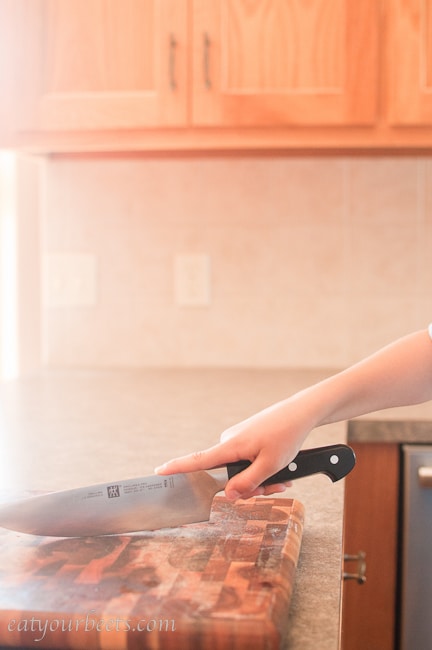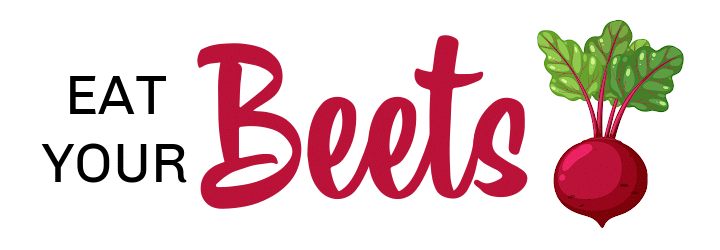Best Knife Safety Tips For Kids
As a preschool teacher who has fed kids many times and studied nutrition for children, I had the opportunity to learn all about kitchen knife safety. Using a knife safely is important for adults and children alike. In fact, it is even more important for children, since they are still learning and developing. With that in mind, I wanted to write this article about the importance of knife safety and share the best knife safety tips for kids.

Contents
Knifes Are Not Toys
Knives are not toys & can definitely cause injury if not properly used or respected. These are tips I’ve picked up along my many years of cooking & what I’ve seen work best with the kids I’ve taught. I encourage you to experiment with your kiddos & see what works best for them! The one thing I’d always recommend is an excellent knife & cutting board as well.
Top Knife Safety Tips For Kids
So here are my top tips for teaching kids to use a knife properly. Kitchen knives can be used by kids and can be used safely with the proper technique and education.
Never Let Kids Use Knives Unsupervised
Never let kids use knives unsupervised: Make sure an adult is always nearby to supervise and provide guidance when needed. Even if a child knows how to use a knife, accidents can still happen and supervision is key.
Always Use A Cutting Board
Always use a cutting board: Cutting boards provide a secure flat surface to stand on and also reduce the risk of an injury. If possible, get a child-sized cutting board so they can easily reach it.
Choose The Right Size Knife
Choose the right size knife for your child’s hands – Each knife has a specific handle size. Make sure you choose knives with handles that fit comfortably in your child’s hands.
Whether using a small paring knife or a serrated knife for larger cutting tasks, finding the right size knife will help them feel more confident and secure. Using the wrong knife size can also lead to an increased risk of injury especially when cutting tricky vegetables like butternut squash.
Practice Knife Skills With Soft Foods
Practice knife skills with soft foods: It’s important to let your little one practice their cutting skills on food that is easy to cut.
Start with softer foods such as bananas, avocados and tomatoes. Gradually move on to harder foods such as carrots and potatoes and other vegetables.
Keep Those Knifes Sharp
It’s important to keep the knife blade sharp. If your child has a knife slip, remind them not to panic and always keep their fingers away from the blade. If you’re feeling nervous, it is best to have an adult take over at that point in time. Keep sharpening steel to help keep your sharp knives in top condition. Sharpening steel will keep the edge of a knife straight and sturdy.
Always Store Knives Properly
Always store knives properly: When not in use, make sure knives are stored safely out of reach of children or within a locked drawer. Knife blocks should be kept out of reach and off the counter. You don’t want the little ones reaching for the knife block or trying to use a sharp knife unsupervised.
Have designated storage boxes for all your kitchen knives and scissors, as well as other sharp objects such as peelers and graters.
Use A Knife Guard
Finally, use a knife guard. Knife guards are great tools to protect and store the blade on a kitchen knife. This is important for keeping your child safe and also keeps knives sharp. Keeping the knife sharp will help prevent slips from a dull blade.
Make Safety A Priority
Most importantly, make safety a priority and have conversations about proper knife usage. Talk to your children about their responsibilities when using knives and the importance of following safety rules.
By incorporating these tips into your kitchen routine, you can help ensure that your kids know how to use knives safely and
Stand At The Right Height
Kitchen counters are built so they are just the right height for most people. You want your kids to stand on a stool or chair that puts the counter at about waist height. They should be able to clearly see what they are cutting.
Teach Proper Knife Techniques
How to properly handle & use a knife was something I taught my daughter pretty early. Good knife skills are very important especially when your little one wants to start helping you in the kitchen. Use these basic knife skills to help build confidence in your kids (& yourself – calm down, mama).
The following kitchen knife safety tips are for using the right knife correctly on a cutting board.
Always Cut Away From Yourself
Always cut away from yourself: Remind your child that when using a knife, they should always cut away from themselves and their hands. This will help reduce the risk of an injury while using a kitchen knife.
How To Hold your Kitchen Knife
Some people feel there is only one way you should hold your knife. I feel that holding a knife is kind of like holding a pencil. If someone has something that works for them, I suggest they use what comes naturally to them.
Different kids may hold their knives differently and you don’t need to worry or encourage them of them to change their hand position. Regardless of whether their hand position is ‘correct’ or not, as long as it is safe they can use it because it’s what is comfortable for them.
You can start your kids out with a smaller knife if an 8 inch chef’s knife seems to cumbersome. See what position your child naturally uses when they hold their knife.
‘The Grip’
You don’t want a falling knife. Teach the kids to grip their knife correctly. Encourage them to hold the knife comfortably in their dominant hand like a pencil. The blade should be facing away from them and the handle should be pointing towards them with the thumb on top of the handle. Once they have a good grip, they can start chopping away!

‘The Pointer’
In their other hand, your child should use a pointer finger to guide the knife. This finger should be curled inwards towards their palm and steady on top of whatever they are cutting., allowing them to control the pressure and speed of the knife as it cuts. Encourage them to keep this finger out of harm’s way at all times.

Rock The Knife
The most common technique your child will be using will have them ‘rocking’ their blade from point to end. Have them start out with the point of the blade on the cutting board.

Then they will push the blade away from them, following the natural curve of the blade.

Keep Fingers Out Of The Way When Using A Sharp Knife
Your children’s fingers will try & grip around whatever they are cutting. When holding smaller things like potatoes or smaller pieces of veg, you don’t want them so curled under that they will get caught as the blade goes through the vegetable.
Since my daughter has smaller hands than mine I notice her natural tendency is to stick the pinky finger in the air.
Just make sure they have a solid hold on their vegetable & as their hands get bigger that pinky should help hold out.
Chop And Draw: Kitchen Knife Safety
Another fun skill your kids can use is ‘The Chop’. Have them place the palm of their free hand flat on the top of the blade.
The kids can then push the knife away from them while moving the knife in a 45 degree direction & then back again.
‘The Draw’ is a good way to cut longer vegetables. My daughter felts more comfortable using a smaller knife when she was younger so she had more control over her drawing motion.
Have the kids place the tip of the blade on the cutting board & draw the tip back towards them.
Slow And Sharp Cutting
I know it might seem frightening but using a sharp knife will actually be more safe than using a dull knife. Dull knives are more likely to slip off of whatever you are cutting, making it more likely for you to cut yourself.
You should also encourage your kids to practice cutting as slowly as possible. If you are right in the middle of making dinner in a rush, it may not be the best time to supervise your child cutting. This is not the time you want to be distracted from what they are doing.
Try not to have the tv in sight or other siblings rushing around & distracting your child as well. Focus is the word you should be thinking of here. Focusing on a secure grip while cutting food on a flat surface will ensure knife safety and at it’s best.
Keep Your Knives Clean
Don’t forget to keep your knives clean. As your children learn the basics of knife safety, make sure they also understand the importance of cleaning their knife after every use.
This helps to prevent bacteria from spreading and keeps their knives in good condition. It is always best to store a knife separately from other kitchen items and away from small hands reach.
Don’t Be Nervous
I hear ya, moms. Some of you are saying you’re just not ready for your kids to start handling knives. I saw a great suggestion online to use play-doh & a lettuce knife for practice until you feel confident in your kid’s knife skills. I think this is a brilliant suggestion & gives you an opportunity to teach knife techniques you & your child feel comfortable with!
Knife Safety Is Super Important
Knife safety is a skill that should be taught to children from a young age. Following these tips will ensure kids are using knives safely and correctly. If you have any additional questions or concerns, talk with your child’s healthcare provider for more information. Thanks for taking the time to read these knife safety tips.
Learn about the best healthy snacks for travel with kids here!







3 Comments
Comments are closed.